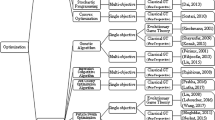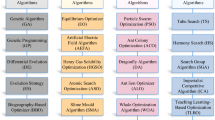Abstract
Game theory is a mathematical tool developed to understand competitive situations in which rational decision-makers interact to achieve their objectives. Game theory techniques have recently been applied to various engineering design problems in which the action of one component impacts that of any other component. In this article we first provide an overview of different game theory formulations, and then we present a survey on the approaches to ship cabin layout design, outlining several open research issues. To this end, we propose an effective method to facilitate the multidisciplinary decision-making process involved. A non-cooperative game is formulated, and the solution of this game is determined by the Nash equilibrium for the amount of equipment and furniture needed for the respective location and to achieve as high performance as possible in a cabin.









Similar content being viewed by others
References
Xiao A, Seepersad CC et al (2007) Design for manufacturing: application of collaborative multidisciplinary decision-making methodology. Eng Optim 39(4):429–451
Helvacioglu S, Insel M (2005) A reasoning method for a ship design expert system. Expert Syst 22(2):72–77
Yang T, Hung C-C (2007) Multiple-attribute decision making methods for plant layout design problem. Robot Compu-Integr Manuf 23(1):126–137
Li J-h, Chen B-k et al (2000) Fuzzy comprehensive evaluation for vessel compartment layout. Shipbuilding China 41(4):22–27
He H-y (2007) Practice in the optimal layout of ship’s cabin. Ship Ocean Eng 36(4):12–14
Xiong M-d (2001) An application of CAD 3D modeling in ship compartment and equipment arrangement. Mech Elect Equip 3:3–6
Li J-h, Chen B-k et al (2001) Optimal layout of vessel compartments based on genetic algorithms on CADDS5 platform. Shipbuilding China 42(1):1–5
Li J-h, Chen B-k et al (2000) Three-dimensional optimal layout design of naval vessel compartments based on simulated annealing method. Comput Aided Eng 1:28–32
Li J-h, Ying W-y et al (2002) Research of method in intelligent 3D layout design of ship compartments based on compound knowledge model. Shipbuilding China 43(2):1–8
Zheng Y (2005) Cabin design of large cargo ship. Ship Boat 5:46–50
Liao Y (2006) Indoor layout of residential house. Housing Sci 55–58
Hou T (2002) Indoor color design research. J ChangChun Univ 12(2) 87–89
Li Z (2007) Seaman psychology and indoor color design. Ship Eng 29(3):75–77
Yao L, Li G-a et al (2006) Analytic hierarchy process applied in large scale surface warship multi-form optimization. Chin J Ship Res 1(3):12–14
Sang S, Lin Y et al (2002) An improved AHP method for MCDM in ship type’s demonstration. J Dalian Univ Technol 42(2):204–207
Xiong Y-f, Cai Z-x et al (2007) Optimal choice of ship forms based on the grey multi-hierarchical appraise model. J Wuhan Univ Technol (Transport Sci Eng) 31(2):337–340
Zhang X-l, Yang J-q et al (2005) Multi-objective fuzzy optimization method and its practical application to engineering design. J Dalian Univ Technol 45(3):374–378
Zhang W-y, Lin Y et al (2004) Model for multi-objects and multi-layers system for ship form fuzzy optimization. Shipbuilding China 45(3):31–37
Chen L, Jin G-d et al (2006) Negotiation model of multidisciplinary collaborative design of product. Chin J Mech Eng 42(8):175–181
Wang J-f, Wu Y-z et al (2002) Genetic algorithms and game theory for high lift design problems in aero dynamics. Trans Nanjing Univ Aeronaut Astronaut 19(1):7–13
von Neumann J, Morgenstern O (1944) Theory of games and economic behavior. Princeton University Press, Princeton
Nash JF (1950) Equilibrium points in N-person games. Proc Natl Acad Sci USA 36:48–49
Nowak MA, Sigmund K (2004) Evolutionary dynamics of biological games. Science 303(5659):793–799
Sim K-B, Lee D-W, Kim J-Y (2004) Game theory based coevolutionary algorithm: a new computational coevolutionary approach. Int J Control Autom Syst 24:463–474
Kaufmann L, Carter CR (2006) International supply relationships and non-financial performance-A comparison of US and German practices. J Oper Manage 24(5):653–675
Habbal A, Petersson J, Thellner M (2004) Multidisciplinary topology optimization solved as a Nash game. Int J Numer Methods Eng 61(7):949–963
Michalek JJ, Papalambros PY, Skerlos SJ (2004) A study of fuel efficiency and emission policy impact on optimal vehicle design decisions. J Mech Des Trans ASME 126(6):1062–1070
Xie N-g, Sun L-s et al (2006) Application of game analysis to multi-objective design of gravity dam. J Hohai Univ (Nat Sci) 34(2):161–164
Xie N-g, Fang H et al (2005) Game analysis of multi-objective design on Luff mechanism of compensative sheave block. J Mech Strength 27(2):202–206
Xie N-g, Sun L-s et al (2005) Multi-objective anti-seismic game design of arch Ring structure. Hydro Sci Eng 4:36–40
Bellman RE, Zadeh LA (1970) Decision making in a fuzzy environment. Manage Sci 17(4):209–215
International Labor Office (2006) 2006 Maritime Labour Convention. International Labor Office, Geneva, Switzerland
Maritime Safety Administration People’s Republic of China (2004). Statutory survey rules for ships and marine facilities, China Communications Press, Beijing
Osborne MJ (2003) An introduction to game theory, Oxford University Press
Author information
Authors and Affiliations
Corresponding author
Additional information
The research was supported by the China Postdoctoral Science Foundation (20060390305).
About this article
Cite this article
Liang, Z.X., Yan, L. & Shang, J.Z. Ship cabin layout design using game theory. J Mar Sci Technol 13, 446–454 (2008). https://doi.org/10.1007/s00773-008-0009-2
Received:
Accepted:
Published:
Issue Date:
DOI: https://doi.org/10.1007/s00773-008-0009-2




